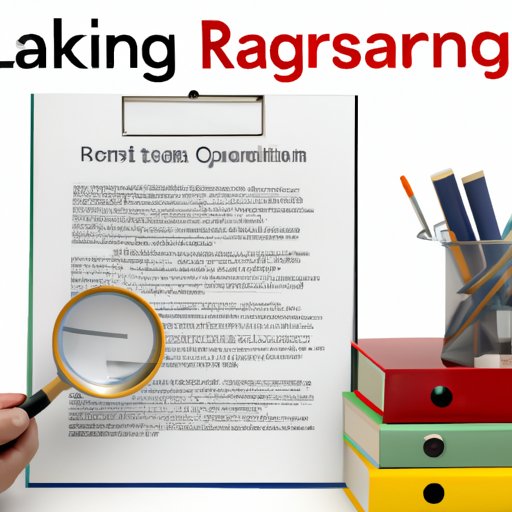Introduction
If you’re looking for a way to turn your passion for painting into a career, starting a painting business could be the right choice for you. With the right planning, you can make a comfortable living while doing something you love. In this article, we’ll provide a comprehensive guide on how to start a successful painting business.
Why Start a Painting Business?
Painting is one of the most popular forms of home improvement, and there’s always a need for reliable and experienced painters. As long as you have the necessary skills and knowledge, you can enjoy a steady stream of clients, lucrative contracts, and financial stability. Plus, you don’t need a lot of money to get started. You can start small and grow your business as your client base expands.
Overview of Steps for Starting a Painting Business
Below is an overview of the steps you’ll need to take in order to start a successful painting business:
- Research local painting regulations and licensing requirements
- Create a business plan and determine financing options
- Purchase necessary equipment and supplies
- Market your painting business
- Find and retain reliable employees
- Develop an effective customer service strategy

Research Local Painting Regulations and Licensing Requirements
Before you start a painting business, you need to research the local regulations and licensing requirements. Depending on where you live, you may need to obtain permits or licenses before you can start operating. Additionally, you’ll need to familiarize yourself with any applicable laws, such as health and safety regulations, environmental protection laws, and labor laws.
Determine Necessary Permits
The first step is to determine which permits or licenses you need in order to operate legally. This will vary depending on your location, so it’s important to do your research. Contact your local government office to find out what permits are required and how to obtain them.
Understand Applicable Laws
It’s also important to understand the applicable laws related to painting businesses in your area. This includes health and safety regulations, environmental protection laws, and labor laws. Make sure you comply with all relevant laws and regulations in order to avoid fines or other penalties.
Investigate Insurance Requirements
You’ll also need to investigate the insurance requirements for running a painting business in your area. Make sure you have the necessary insurance coverage to protect yourself and your business from potential liabilities. Talk to an insurance broker for advice on the best type of policy for your needs.
Create a Business Plan and Determine Financing Options
Once you’ve taken care of the legal aspects of starting a painting business, it’s time to create a business plan. This will help you define your target market, choose your business structure, estimate startup costs, and explore financing options.
Define Your Target Market
The first step in creating a business plan is to define your target market. Who are you going to be targeting with your painting services? Are you going to focus on residential customers or commercial customers? Knowing who your target customers are will help you create an effective marketing strategy.
Choose Your Business Structure
You’ll also need to decide on a business structure for your painting business. The most common options are sole proprietorship, limited liability company (LLC), partnership, and corporation. Each has its own advantages and disadvantages, so make sure you do your research before making a decision.
Estimate Startup Costs
Once you’ve chosen your business structure, you’ll need to estimate the startup costs. This should include the cost of purchasing necessary equipment and supplies, obtaining licenses and permits, advertising, and hiring employees. Add up all of these costs to get an accurate picture of how much money you’ll need to get your business off the ground.
Explore Financing Options
Finally, you’ll need to explore financing options. Depending on your credit history and the amount of capital you need, there are a variety of options available. These include traditional bank loans, SBA loans, venture capital, crowdfunding, and more. Consider all of your options and find the best solution for your needs.

Purchase Necessary Equipment and Supplies
Once you have the necessary financing in place, it’s time to purchase the equipment and supplies needed for your painting business. This includes brushes, rollers, ladders, drop cloths, tarps, paint, and more. Do some research to compare prices and quality of different products before making a purchase.
Identify Essential Equipment and Supplies
The first step is to identify the essential equipment and supplies that you need for your painting business. Make a list of everything you’ll need in order to complete the jobs you plan to take on. This will help you determine how much you need to spend and where you can save money.
Compare Prices and Quality
Once you have a list of essential items, you can start comparing prices and quality of different products. Don’t just go for the cheapest option – make sure you’re getting good value for your money. Look for products that offer the best combination of price and quality.
Market Your Painting Business
Now that you have all the necessary equipment and supplies, it’s time to start marketing your painting business. There are a number of different ways you can do this, including developing a website, utilizing social media platforms, and taking advantage of word-of-mouth advertising.
Develop a Website
Creating a website is a great way to reach potential customers and show off your work. Use high-quality photos of your previous projects to demonstrate your skills and expertise. Be sure to include contact information and a call to action, such as a “contact us” page.
Utilize Social Media Platforms
Social media platforms are another great way to reach potential customers. Create accounts on popular platforms like Facebook, Twitter, and Instagram, and post regular updates about your business. Include photos of your work, testimonials from satisfied customers, and special offers.
Take Advantage of Word-of-Mouth Advertising
Word-of-mouth advertising is one of the most effective ways to market your painting business. Ask satisfied customers to recommend your services to their friends and family. You can also offer referral bonuses to encourage people to spread the word about your business.
Find and Retain Reliable Employees
As your business grows, you may decide to hire additional employees to help with the workload. Finding and retaining reliable employees is key to success. Develop job descriptions, recruit qualified candidates, and provide training and support to ensure your employees are productive and motivated.
Develop Job Descriptions
The first step is to develop detailed job descriptions for each position. Include the duties and responsibilities of the job, as well as the qualifications and experience you expect from applicants. This will help you narrow down your search and find the best candidates for the job.
Recruit Qualified Candidates
Once you have job descriptions in place, you can start recruiting qualified candidates. Post the positions on job boards, advertise in local newspapers, and attend job fairs. Take the time to interview each candidate and make sure they have the necessary skills and experience.
Provide Training and Support
Once you’ve hired your employees, it’s important to provide them with training and support. Make sure they understand the expectations and have the tools and resources they need to succeed. Provide ongoing feedback and praise to keep them motivated and help them reach their full potential.

Develop an Effective Customer Service Strategy
Excellent customer service is essential for a successful painting business. Develop an effective customer service strategy to ensure that your customers are satisfied with your services. Set clear expectations, ensure quality work, and resolve conflict quickly.
Set Expectations
The first step is to set expectations with your customers. Explain the process clearly and provide a timeline for completion. Make sure they understand the fees and any additional costs that may be involved. This will help prevent misunderstandings and ensure a smooth working relationship.
Ensure Quality Work
Make sure you deliver quality work every time. Go above and beyond to exceed your customers’ expectations. Pay attention to details and take the time to do the job right. This will help you stand out from the competition and build a good reputation.
Resolve Conflict Quickly
No matter how hard you try, conflicts may arise between you and your customers. It’s important to resolve them quickly and professionally. Listen to their concerns and address them in a timely manner. This will help maintain a positive relationship and ensure your customers remain satisfied.
Conclusion
Starting a painting business can be an incredibly rewarding experience. With the right planning and dedication, you can turn your passion into a profitable career. By researching local regulations and licensing requirements, creating a business plan, purchasing necessary equipment and supplies, marketing your services, finding and retaining reliable employees, and developing an effective customer service strategy, you can set your painting business up for success.
Summary of Steps to Starting a Painting Business
To sum up, here are the steps you’ll need to take to start a successful painting business:
- Research local painting regulations and licensing requirements
- Create a business plan and determine financing options
- Purchase necessary equipment and supplies
- Market your painting business
- Find and retain reliable employees
- Develop an effective customer service strategy
Final Words of Encouragement
Starting a painting business takes hard work and dedication, but it can be an incredibly rewarding experience. With the right planning and preparation, you can turn your passion into a successful career.
(Note: Is this article not meeting your expectations? Do you have knowledge or insights to share? Unlock new opportunities and expand your reach by joining our authors team. Click Registration to join us and share your expertise with our readers.)
